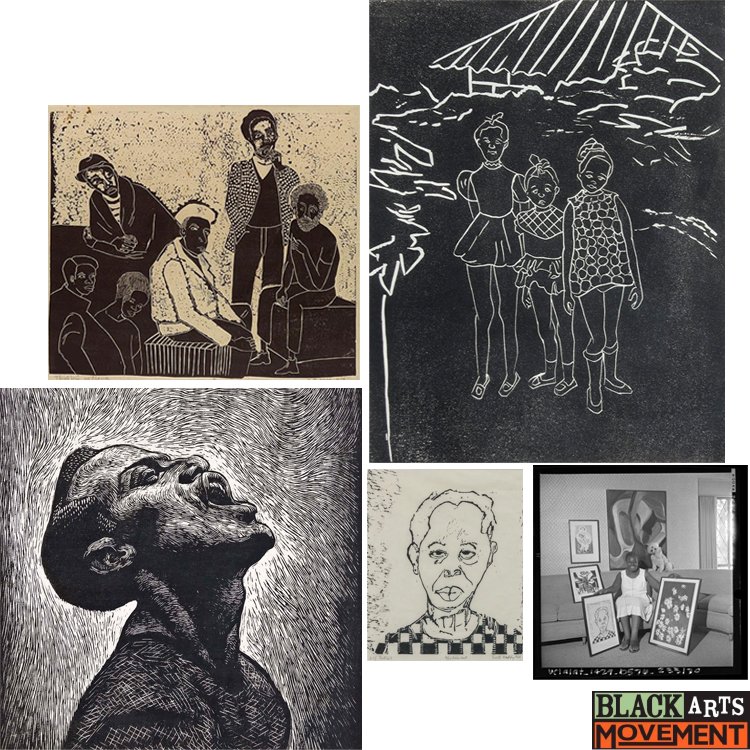#sparkchamber 022624 Ruth Waddy
Celebrating Black History Month, #sparkchamber continues to highlight the fierce women of the Black Arts Movement. Today, we shine a spotlight on Ruth Waddy, a “painter, printmaker, and advocate of artistic opportunity,” and a “prophet exclaiming the news of black artists and calling upon the world to embrace them.” Indeed, in the late 1960s, Waddy became one of the most important advocates for African American art in California and across the United States.”
She was born Willanna Ruth Gilliam on January 7, 1909, in Lincoln, NE, and was raised in Minneapolis, MN. With aspirations to be a teacher, she enrolled at the University of Minnesota, but was forced to drop out to help support her family during the Great Depression. “After trying to make a living in Chicago, where she was denied a job as a solderer during World War II because of her race, Waddy, then a young mother, left the Midwest for Los Angeles. In California she worked as a riveter for Douglas Aircraft Corporation and held other odd jobs [including as an intake clerk at Los Angeles County Hospital, where she worked with Noah Purifoy] before taking a ceramics class that sparked her interest in art. Waddy went on to study art through the Famous Artists Home Study Course and at Los Angeles City College and Otis Art Institute, quickly becoming an adept printmaker whose favored medium was linocut. She exhibited her prints widely in the United States and traveled to the Soviet Union in 1966 as part of a delegation of eight American artists. Traveling on the recommendation of Charles White, who had made the same trip several years earlier, Waddy carried her own work abroad as well as twenty prints created by other Black California artists.
“Before her trip to the U.S.S.R., Waddy had journeyed cross-country via Greyhound bus to collect prints by Black artists for the 1965 volume Prints by American Negro Artists, edited by Theodore V. Roelof-Lanner and published by the Cultural Exchange Center in Los Angeles. In 1969 Waddy also contributed her extensive knowledge of contemporary African American artists to the influential two-volume series Black Artists on Art, co-edited with artist, teacher, and gallerist Samella S. Lewis. In her introduction, Waddy clearly outlines her view of art making: “Art is not an intellectual exercise, approached through structured learning, emotions, styles, and practised [sic] in museums, galleries, and private ‘collections.’ Art is spiritual, the primary function of which is for the benefit, growth and improvement of the human animal.” She adds, “From whatever point of view, aesthetic or social, [the black artist] has always had to tell it like it is.”
“Despite Waddy’s achievements as a fine artist, she always insisted on characterizing herself first and foremost as an arts organizer and advocate. In addition to her work with Roelof-Lanner and Lewis, Waddy brought together a group of preeminent black artists to form the organization Art West Associated. Beginning with little knowledge of the Los Angeles art scene, Waddy collected the names of black artists making work respected by their peers. She first contacted Daniel LaRue Johnson, who directed her to Melvin Edwards, who in turn told her about George Clack, and so on. Describing herself as a non-artist, Waddy convened a meeting of black artists in 1962 in the back room at the Safety Savings and Loan Company, where Art West Associated was born.
“With funding from the National Endowment for the Arts as well as other local arts programs, Art West Associated organized juried shows and sold prints through advertisements in African American magazines such as Essence, among other activities. The Los Angeles–based group had a sister chapter in San Francisco called Art West Associated North. For her central role in bringing artists together to promote their work, Waddy did not go unrecognized. She received numerous national awards for leadership over the course of her career and has been regarded with great admiration by those with whom she worked. As artist Alonzo Davis remarked, ‘What I got from Ruth was her strength of belief in the African American culture.’”
Ruth Waddy died on May 24, 2003, at age 94, in San Francisco, California. Thank you for your voice, Ms. Waddy.
1.] Where do ideas come from?
Something that I see in a magazine or a newspaper makes me think of something. But I wouldn’t say that the idea was original. It’s prompted by something that I've seen. The idea is prompted by something that I’ve seen.
2.] What is the itch you are scratching?
From whatever point of view, aesthetic or social, [the Black artist] has always had to tell it “like it is.”
3.] Early bird or night owl? Tortoise or hare?
Art is not an intellectual exercise, approached through structured learning, emotions, styles, and practiced in museums, galleries, and private “collections.” Art is spiritual, the primary function of which is for the benefit, growth, and improvement of the human animal.
4.] How do you know when you are done?
Usually if I start something, I'll finish it, usually. Although I can think of my failings better than I can of my successes.



